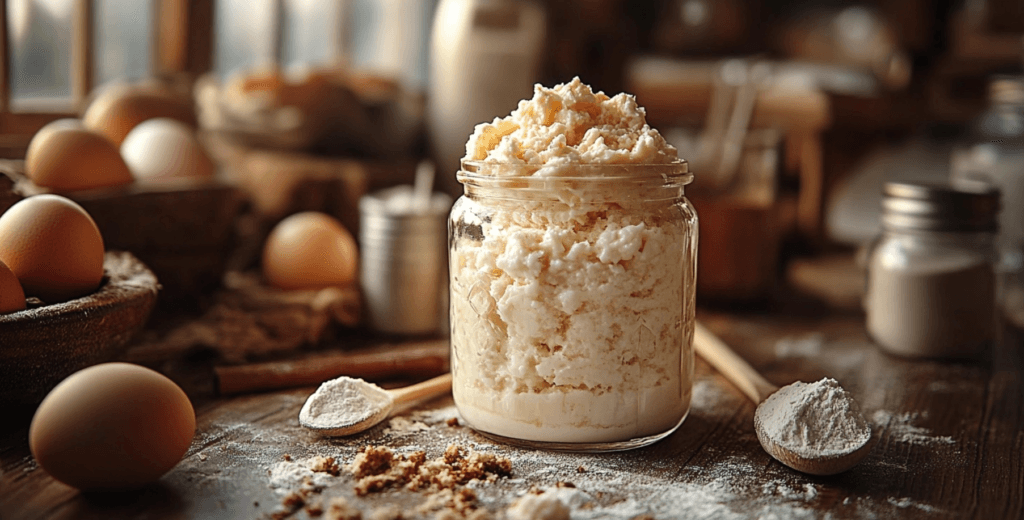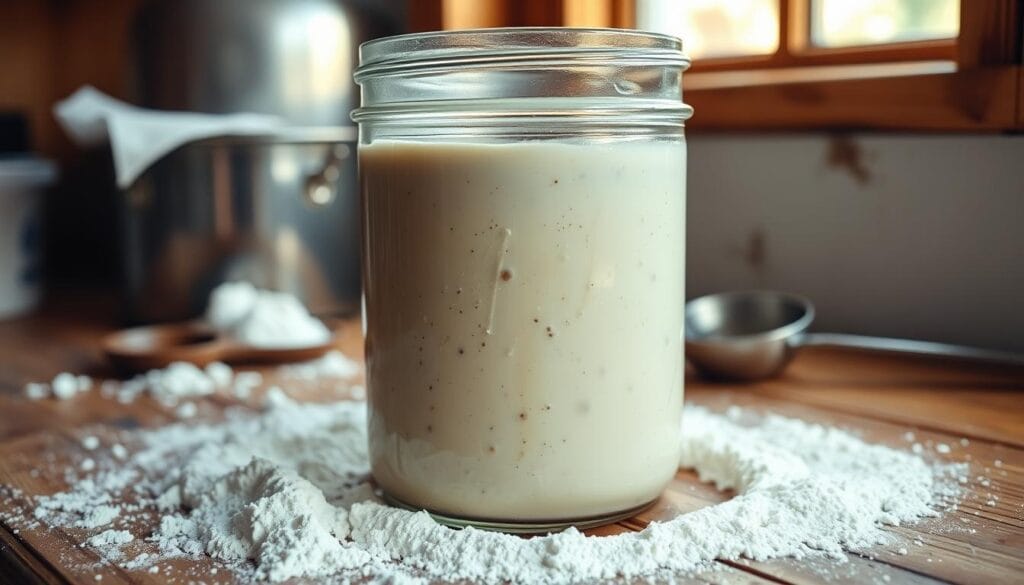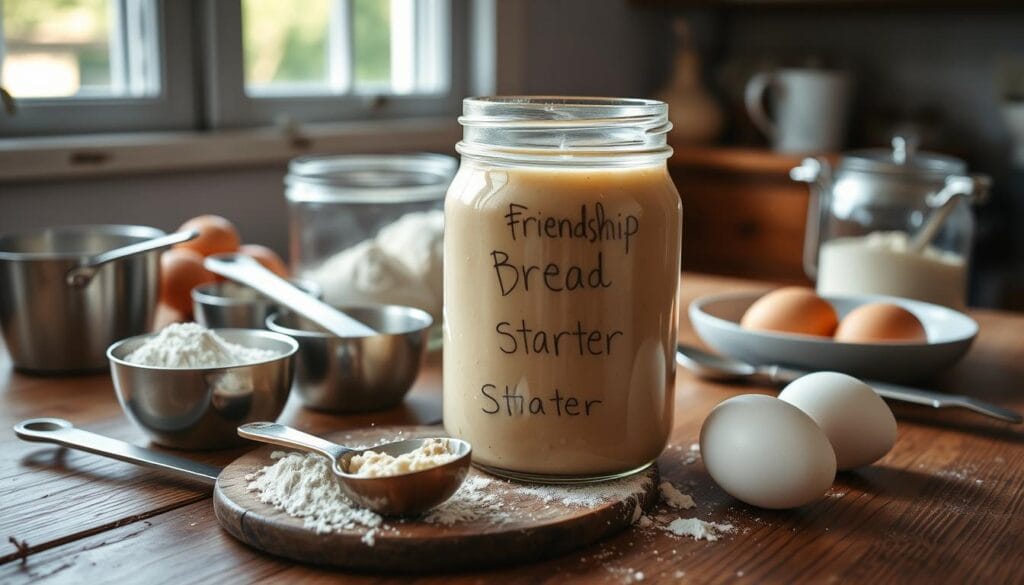I love baking at home and getting excited about an Amish Friendship Bread starter. But sometimes, it doesn’t bubble right away. This can make us wonder, “Why isn’t my starter bubbling?” These starters are like sourdough siblings – they all have their own special needs.
Every Amish Friendship Bread starter is different. This is because of many things like your home’s temperature and the type of milk you use. Even if they come from the same starter, they can grow into unique bread-making friends.
Main Highlights :
- Amish Friendship Bread starters can be finicky due to variations in kitchen environments, ingredients, and maintenance routines.
- Factors like wild yeast, milk types, and feeding schedules can affect starter activity and bubbling.
- A “quiet” starter may be dormant due to cold temperatures or simply need to be fed.
- Starters stored in the fridge or freezer for long periods may change color, but can often be revived with proper care.
- Each starter is unique, so their behavior can vary even when divided from the same source.
Understanding Your Amish Friendship Bread Starter
Keeping your Amish Friendship Bread starter healthy is crucial for tasty loaves. A good starter is a live culture that lasts forever with care. Let’s look at what makes a starter healthy, the signs of fermentation, and the role of wild yeast.
What is a Healthy Starter?
A healthy starter shows clear signs. It should bubble and smell yeasty within 24-48 hours after feeding. It feels light and airy, with a soft color and lively bubbles.
Signs of Active Fermentation
Active fermentation means bubbles and a bit more starter. Wild yeast and bacteria eat sugars, making carbon dioxide. This makes the starter rise and adds flavor.
The Role of Wild Yeast
Wild yeast is key to a good starter. Found in the air and on grains, it ferments sugars and starches. This creates the starter’s rise and taste.
Your starter’s behavior changes with the environment and feeding. Knowing what a healthy starter looks like helps keep it active. This ensures your bread turns out delicious.
Temperature Matters: The Impact of Kitchen Environment
The temperature in your kitchen is key for your Amish Friendship Bread starter. It needs a cozy spot between 70-80°F (21-27°C) to be active. This range helps the wild yeast and bacteria grow, making the starter lively and bubbly.
If your kitchen is cool or drafty, your starter might slow down. On the other hand, a very warm kitchen can make the starter too active. This can cause it to overflow its container.
To keep your starter healthy, watch the kitchen temperature closely. If it’s slow, try moving it to a warmer place. Near a preheated oven or sunny windowsill works well. This can help it become lively again.
The bread baking science of Amish Friendship Bread depends on the fermentation environment and starter activity. Keeping the kitchen temperature right helps your starter thrive. This way, you can make delicious homemade bread.

Why is my Amish Friendship Bread starter not bubbling
If your Amish Friendship Bread starter isn’t bubbling, there are a few reasons. An inactive starter or dormant starter means it’s not fermenting. But, with some easy troubleshooting tips, you can make it bubble again. This will help revive your friendship bread starter.
Common Causes of Inactivity of Amish Friendship Bread Starter not Bubbling
- Low temperature – Amish Friendship Bread starters need warmth, between 70-85°F. If it’s too cold, they might stop growing.
- Inadequate feeding – Not feeding your starter or using the wrong mix can cause it to slow down.
- Using chlorinated water – Chlorine can harm the good yeast and bacteria your starter needs.
Signs of a Dormant Starter
A dormant starter looks and smells different. You might see:
- No bubbles or growth after feeding
- A flat, lifeless look with no rise
- No sour, yeasty smell
Troubleshooting Steps
To fix a non-bubbling starter, try these steps:
- Put the starter in a warmer spot, between 70-85°F.
- Make sure you’re using the right mix of flour, sugar, and water without chlorine.
- If it still doesn’t work after 72 hours of feeding, it might be time to start over.
By fixing these common problems and following these tips, you can get your starter bubbling again. Then, you can enjoy baking with your Amish Friendship Bread starter.

Proper Feeding Schedule and Ratios
To keep your Amish Friendship Bread starter healthy, follow a regular feeding schedule and use the right ratios. The best ratio is 1 cup of starter to 1 cup each of flour, sugar, and milk. This 1:1:1:1 ratio helps the starter get the nutrients it needs to stay lively.
Feed your starter every 4-5 days. Feeding too much or too little can upset the starter’s balance. For bigger starters, just multiply the ingredients while keeping the 1:1:1:1 ratio.
If you have too many starters, it’s okay to throw some away before feeding. Keeping the starter size manageable helps you stick to your feeding plan. Regular feeding is crucial for a healthy starter that makes great Amish Friendship Bread.
| Starter Feeding Ratio | Feeding Schedule | Storage Guidelines |
|---|---|---|
| 1 cup starter : 1 cup flour : 1 cup sugar : 1 cup milk | Every 4-5 days |
|
By sticking to this simple feeding plan and ratio, you’ll have a thriving Amish Friendship Bread starter. You’ll also enjoy making delicious homemade bread. Happy baking!

The Science Behind Starter Activity
The fermentation in the Amish Friendship Bread starter is cool. It’s a mix of wild yeast and good bacteria. The yeast eats sugars, making carbon dioxide and acids like lactic and acetic.
This process makes the starter bubbly and tangy. It’s also key for baking chemistry.
Understanding Fermentation Process
The starter’s fermentation is driven by wild yeast. This yeast eats sugars from the flour. It makes carbon dioxide bubbles, causing the starter to rise.
The acids made also add to the bread’s unique taste.
Role of Sugar and Flour
Sugar is the yeast’s main food. Flour gives more carbs and nutrients. The right mix of sugar and flour keeps the starter healthy and active.
Importance of Fresh Ingredients
Using fresh, good ingredients is very important. Bad flour or sugar can harm the starter. It might not ferment well or grow bad stuff.
With fresh, healthy ingredients, your starter stays strong. It will make tasty bread.
Creating the Perfect Environment for Your Starter
To keep your Amish Friendship Bread starter alive and kicking, pay close attention to your kitchen. Focus on making the perfect spot for it to ferment.
For a great starter home, you need warmth, no drafts, and a clean, covered spot. Don’t use metal because it can harm the starter. Glass, ceramic, or food-grade plastic are better choices.
Stirring your starter every day helps it get the nutrients it needs. Also, keep it where you can see it. This will remind you to feed and care for it regularly.
With the right starter environment, you’re on your way to making tasty Amish Friendship Bread. The fermentation conditions you create will make your bread better and more consistent.
| Ideal Starter Environment | What to Avoid |
|---|---|
|
|
Signs of a Healthy vs. Unhealthy Starter
Keeping a healthy starter is key for great sourdough maintenance and bread troubleshooting. Knowing the signs of a thriving starter health helps. This way, your fermentation signs stay strong, making baking rewarding.
Visual Indicators
A healthy starter shows lots of bubbles. This means it has lots of wild yeast and lactic acid bacteria. It should be light in color, without any mold or discoloration.
An unhealthy starter might turn pink or show little activity. It might also have liquid on top, called “hooch”.
Smell and Texture Guidelines
A good starter smells tasty and nice. If it smells like acetone, even after feeding, it’s time to start over. A healthy starter is thick and stretchy, not too runny.
Watching for these signs helps keep your sourdough maintenance on track. This leads to better bread troubleshooting and tasty results.
Reviving an Inactive Starter
If your Amish Friendship Bread starter is not active, don’t worry. You can make it active again with a bit of care. Just follow a few easy steps to wake up the yeast and bacteria.
First, throw away all but 1 cup of starter. This makes the remaining microorganisms stronger. Then, feed this 1 cup with 1 cup each of flour, sugar, and milk. This mix gives the starter what it needs to grow.
Put the starter in a warm place, like 76-80°F (24-26°C). Let it sit for 24-48 hours. Watch for signs like bubbles, rising, and a nice smell. If you don’t see these signs, feed it again.
- Discard all but 1 cup of the existing starter
- Feed the 1 cup of starter with 1 cup each of all-purpose flour, sugar, and milk
- Place the refreshed starter in a warm spot (76-80°F/24-26°C) for 24-48 hours
- Monitor for signs of activity, such as bubbling, rising, and a pleasant yeasty aroma
- If no activity is observed, repeat the feeding process
If your starter smells like acetone or alcohol, it’s too acidic. Throw away most of it and feed what’s left. This will balance the starter’s pH and wake up the good bacteria.
Reviving a starter might take some time and effort. But with the right steps, you can revive your starter and bake delicious Amish Friendship Bread again. Good luck with your sourdough troubleshooting and bread-baking tips!
Conclusion
Keeping an Amish Friendship Bread starter healthy needs care and attention. Knowing about temperature, feeding times, and good ingredients is key. This ensures your starter stays active and ready for baking.
If your starter is not active, you can fix it. Just tweak the temperature and how often you feed it. With the right care, your starter can live forever.
The Amish Friendship Bread tradition is more than just tasty bread. It’s about community and sharing. By learning to care for your starter, you keep this tradition alive. Enjoy the delicious results of your baking.
Watch your starter closely and make changes when needed. Embrace the journey of Amish friendship bread, sourdough starters, and bread-baking tips.
With good starter maintenance, you’ll make amazing amish friendship bread. It celebrates the Amish values of simplicity, generosity, and connection. So answering Why Your Amish Friendship Bread Starter Isn’t Bubbling?
FAQ
Why is my Amish Friendship Bread starter not bubbling?
Your starter might be sleeping because it’s too cold or needs to be fed. Things like yeast, milk, and how often you feed it can change how it acts. Try warming it up, feeding it right, and using clean water.
What are the signs of a healthy Amish Friendship Bread starter?
A good starter bubbles within 24-48 hours after feeding. It smells nice and is light in color. You’ll see bubbles and it will grow a bit.
What is the role of wild yeast in Amish Friendship Bread starter?
Wild yeast makes the starter taste good and helps it rise. How it acts can change based on where it is and how often you feed it.
How does kitchen temperature affect Amish Friendship Bread starter activity?
The starter likes it warm, between 70-80°F (21-27°C). This helps it work faster. If it’s too cool, it might slow down or stop.
What are common causes of Amish Friendship Bread starter inactivity?
It might not be active if it’s too cold, not fed enough, or has chlorinated water. Look for no bubbles, no growth, and a flat look.
What are the proper feeding ratios for Amish Friendship Bread starter?
Feed it 1 cup starter to 1 cup each of flour, sugar, and milk every 4-5 days. Too little or too much can slow it down.
How does the fermentation process work in Amish Friendship Bread starter?
Yeast and bacteria eat sugars, making carbon dioxide and acids. Sugar feeds the yeast, and flour adds nutrients and structure.
What is the ideal environment for Amish Friendship Bread starter?
It needs a warm spot, away from drafts, in a clean container. Stirring daily helps it work evenly.
How can I tell if my Amish Friendship Bread starter is healthy or unhealthy?
A healthy starter bubbles, smells good, and is light. An unhealthy one might have mold, turn pink, or smell bad.
How can I revive an inactive Amish Friendship Bread starter?
Start by throwing away most of the starter and feeding it 1 cup each of flour, sugar, and milk. Keep it warm and wait 24-48 hours. If it doesn’t work, try again.

